The Ryzen 5 launch was a lot better for budget minded gamers but all eyes have been on the Ryzen 3 launch to see if AMD is going to pull off the hat trick. Plus AMD has traditionally been the perfect company to go with when doing gaming PCs on a small budget. While the Ryzen 5 CPUs are great, they don’t really help with those builds. Today is the official launch day for Ryzen 3 and I’ve spent the last few weeks testing and playing around with it. I’m excited to give a quick run down on the details then dive into the performance numbers to see how it performs.
Product Name: AMD Ryzen R3 CPUs
Review Sample Provided by: AMD
Written by: Wes
Pictures by: Wes
AM4 Testbench also supported by: Corsair, Asus, and Noctua
Ryzen R3
Okay before I jump into testing we do need to recap a little. With Ryzen 7 and Ryzen 5 already launched we have learned a few things about AMD's naming. For starters, the 7,5, and 3 setup is similar to Intel's I series but AMD hasn’t set hard limits like Intel did. So for example with Intel i7’s are the only CPUs with hyper threading and both i7 and i5’s all have quad cores, then i3’s are the cheaper dual cores. AMD tossed all of that out and we have all 8 cores for the R7’s and then for R5’s they have 4 and 6 core SKUs and all of those have twice the number of threads to cores. But with R3 AMD dropped the additional threads but stuck with the core counts so both the 1300X and the 1200 have four cores. This should make things especially interesting next to Intel's i3’s with their dual cores.
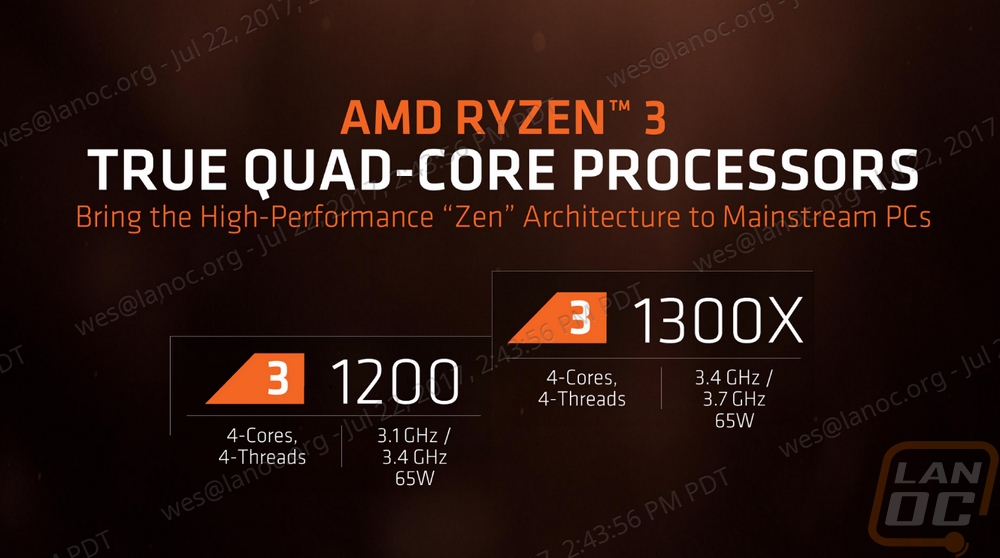
The other thing we have learned is with Intel the K designation means the SKU is overclockable and then X means it is a top tier SKU. AMD left all of their CPUs overclockable assuming the motherboard supports it and the X here means a higher XFR boost to the clock speeds. So the R7 X models get 100 MHz where the non-X models only get 50. R5’s were more confusing, the 6 core models all had 100 MHx XFR with the non-X 4 core having 50 and the 1500X getting a 200 MHz boost. So where does that leave the two new R3 SKUs? The 1300X gets that same 200 MHz boost and the 1200 gets the 50 MHz boost.
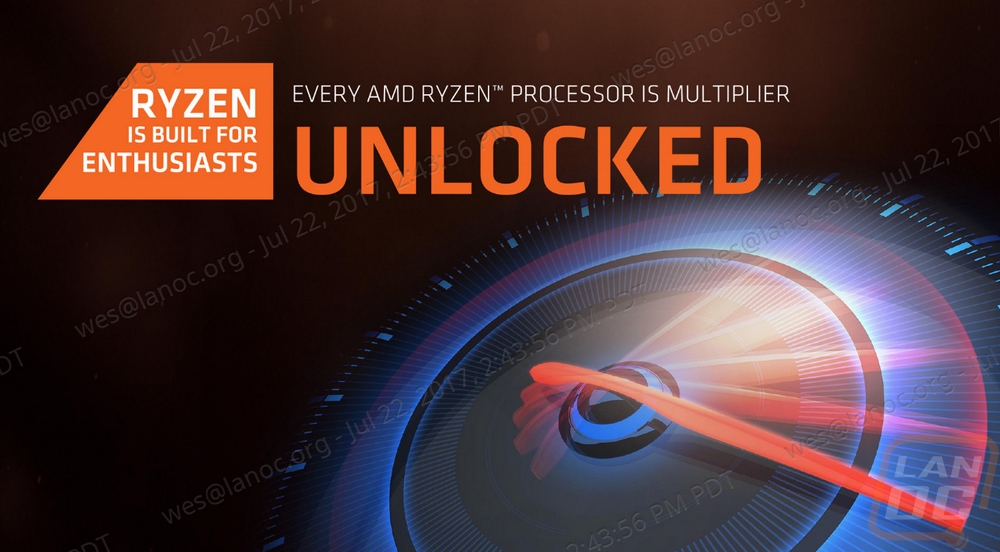
In fact the R5 1500X shares a lot with the R3 1300X and the R5 1400 shares a lot with the R3 1200. The R5 1500X and R3 1300X have the same clock speeds and core count with the two differences being the additional threads on the R5 1500X and the 16MB L3 Cache where the 1300X has 8MB. The R5 1400 and the R3 1200 are close on clock speeds as well only the 1200 has a lower base frequency. They have the same 4 core count but the 1400 has twice the threads but they do have the same 8MB L3 Cache.
|
|
R7 1800X |
R7 1700X |
R7 1700 |
R5 1600X |
R5 1600 |
R5 1500X |
R5 1400 |
R3 1300X |
R3 1200 |
|
Base Frequency |
3.6 GHz |
3.4 GHz |
3.0 GHz |
3.6 GHz |
3.2 GHz |
3.5 GHz |
3.2 GHz |
3.5 GHz |
3.1 GHz |
|
Boost Frequency |
4 GHz |
3.8 GHz |
3.7 GHz |
4.0 GHz |
3.6 GHz |
3.7 GHz |
3.4 GHz |
3.7 GHz |
3.4 GHz |
|
Physical Cores |
8 |
8 |
8 |
6 |
6 |
4 |
4 |
4 |
4 |
|
Logical Cores |
16 |
16 |
16 |
12 |
12 |
8 |
8 |
4 |
4 |
|
L3 Cache |
16 MB |
16 MB |
16 MB |
16 MB |
16 MB |
16 MB |
8 MB |
8 MB |
8 MB |
|
TDP |
95W |
95W |
65W |
95W |
65W |
65W |
65W |
65W |
65W |
|
XFR |
+100 |
+100 |
+50 |
+100 |
+100 |
+200 |
+50 |
+200 |
+50 |
|
Price |
$499.99 |
$399.99 |
$349.99 |
$249.99 |
$219.99 |
$189.99 |
$169.99 |
$129 |
$109 |
|
Cooler |
N/A |
N/A |
Spire RGB |
N/A |
Spire |
Spire |
Stealth |
Stealth |
Stealth |
For coolers, both of the Ryzen 3 models come with the same Stealth cooler than the R5 1400 came with. It is a shorter version of the Spire and doesn’t have any fancy RGB lighting or anything like that. When on the call with AMD though they did also announce that they will finally be selling the Wraith MAX cooler. I suspect the hype on that cooler has died down a little now that we are this far past the launch and there are finally other AM4 options around but it is a great cooler. I tested it back in April, check out the coverage. I will be doing a big Ryzen cooler test here on the website as well so keep an eye out for that one. I will include all of the coolers as well as a whole box of other coolers that I have waiting for me to get into once this coverage is up.
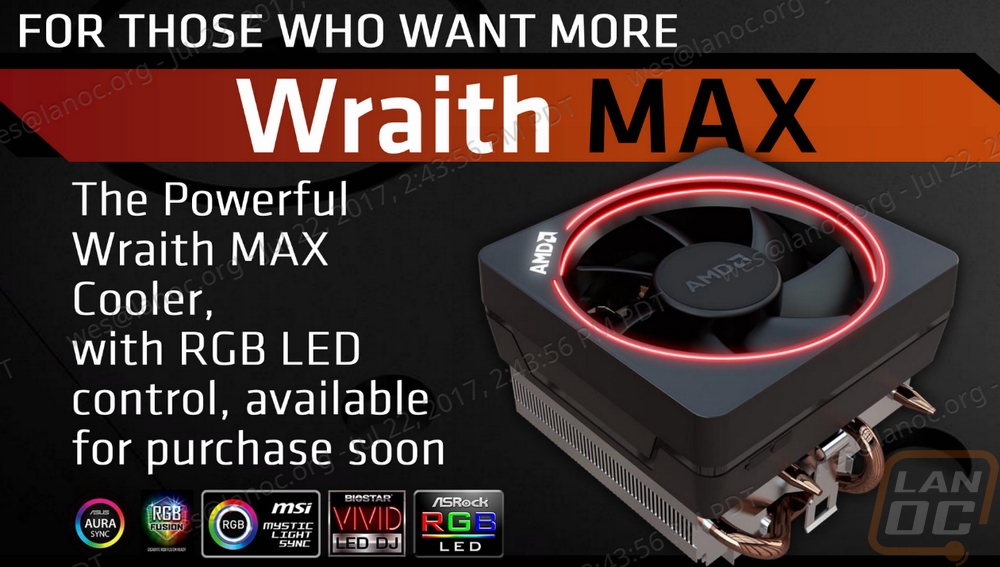
In addition to Ryzen 3, AMD is quietly also introducing new A series APUs for the AM4 platform. Before you get too excited, none of these are Ryzen based. The idea here is to bring updated SKUs using a little older architecture to start getting APU options out on the market. This finally will put those display connections we have been seeing on AM4 boards to use with the on board video. Hopefully, we can take a look at some of them later. I’m mostly excited as they will also be a great way to build a cheap AM4 system that you can upgrade to Ryzen and a dedicated GPU later on.
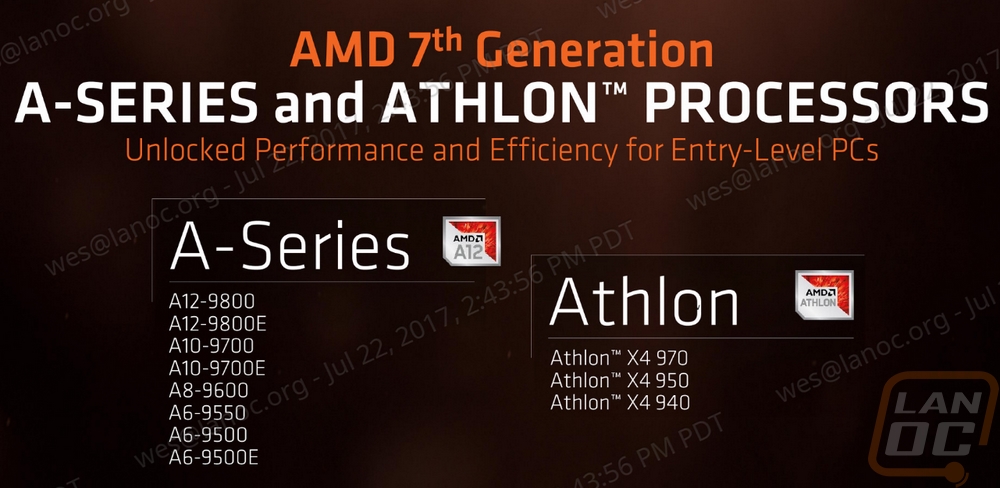
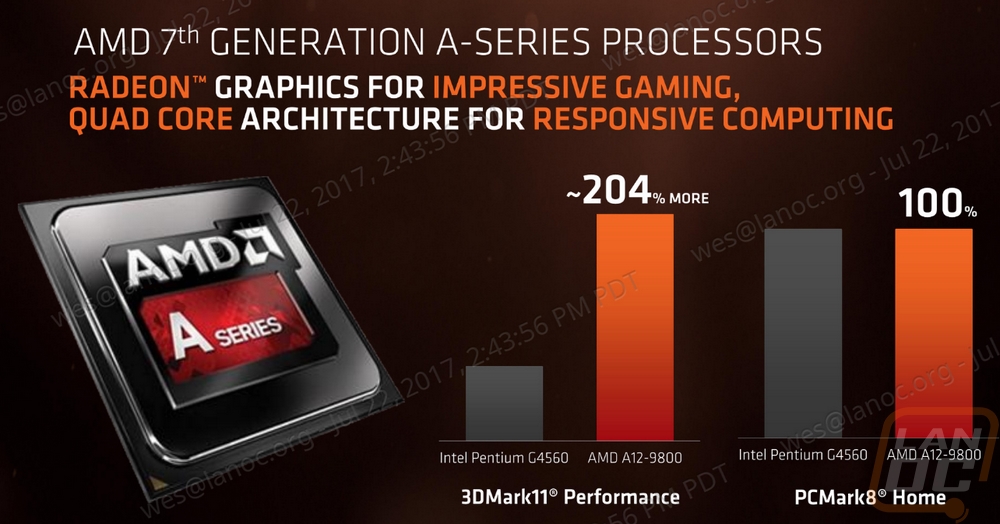
To me, that is one of the most exciting things about AM4 as a whole. It covers a wide range of hardware allowing people true upgrade paths were Intel's current setup doesn’t allow for big upgrades in the future on the mainstream CPUs and the buy in for the X299 platform is far too high to consider it a budget build in the first place. Right now we have the X370 chipset for enthusiast builds, B350 for mainstream, and the A320 chipset is starting to trickle out as well for cheaper builds. A320 still has some of the features but drops overclocking and like B350 doesn’t have dual PCIe Graphics capabilities. Not listed in the picture below are the two ITX based options. I asked AMD and they seem to be putting the ball in motherboard manufacturers hands saying that we should start to see more 300 based boards as the APUs start to come out and the need for smaller boards grows. I would argue that ITX AM4 options as a whole have been extremely in demand and impossible to get up until recently where on Intel platforms you can normally get ITX options at launch or at least close to it. I really hope ITX opens up more soon.
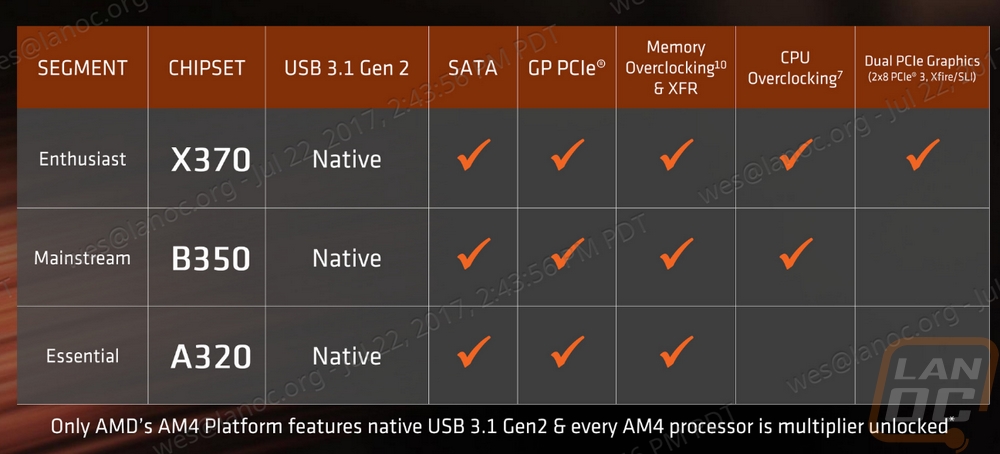
I also snapped pictures of the two CPUs that came in for this launch. I’ve already covered just about everything about them and the cooler. But here is the packaging.

Inside the box, you get a plastic tray with the CPU and a Ryzen 3 sticker. Both of the CPUs have the same look going as Ryzen 5 and Ryzen 7. You get that cool looking Ryzen logo on top and the old school pins on the CPU that some people love and others hate.




The stealth cooler is a short aluminum based cooler. The top fan looks just like the Spire cooler only without the RGB lighting. It does have the AMD logo up on top and on the center of the fan. The fan is as thick or thicker than the heatsink and it should be an option for ITX or low profile builds. When flipped upside down we can see it does come with thermal paste pre-applied and the heatsink Is aluminum all the way to the contact area. I do love the screw based mounting that should be a lot easier to work with than the old school clips that the Wraith cooler still has.




Test Rig and Procedures
|
Intel Z270 Test System |
||
|
Motherboard |
Asus Crosshair VI Hero |
|
|
Cooling |
Noctua NH-U12S for cooling Noctua NT-H1 Thermal Paste |
|
|
Memory |
Corsair Vengeance LPX DDR4 2x8 16GB 3000MHz @2933 |
|
|
Storage |
Kingston HyperX 240GB SSD |
|
|
Video Card |
Nvidia GTX 1080 Ti |
|
|
Power Supply |
Thermaltake 850w |
|
|
Case |
Microcool Banchetto 101 Test bench |
|
|
OS |
Windows 10 Pro 64-bit |
|
|
CPU Testing Procedures |
|
|
Team Fortress 2 |
1080p – high, very high, high, reflect world, high, enabled, 8x msaa, x16, multicore on. Testing is then run with this benchmark |
|
Ashes of the Singularity: Escalation |
1080p – Standard quality setting, DX12, built in benchmark on the CPU-focused setting |
|
Tom Clancy's Ghost Recon: Wildlands |
Built-in Benchmark, 1080p, High detail setting |
|
Deus Ex: Mankind Divided |
1080p – Ultra Setting – DX11 – Vsync Turned off using built-in benchmark |
|
Dolphin 5.0 Benchmark |
For information on configuration, view this thread |
|
3DMark Fire Strike |
Physics Score – Performance benchmark |
|
7-Zip |
Built-in benchmark set to 32MB, run 4 passes |
|
Jetstream |
http://browserbench.org/JetStream/ |
|
wPrime |
1024M |
|
X264 HD Benchmark |
Pass 1 and Pass 2 |
|
Cinebench R15 |
CPU and CPU (Single Core results) |
|
Passmark 8 |
CPU Mark Score |
|
PCMark 10 |
Normal test ran, not the express or extended |
|
AIDA64 |
Memory, Cache, and FLOPS testing done with built in GPGPU and Memory benchmarks |
|
Power Usage |
Idle and load testing using a Kill-A-Watt and wPrime to put the CPU under load |
|
Temps |
Aida64 stability test to load and to record temperature readings |
CPU Performance
For performance testing, I busted out our AM4 test platform with its Asus Crosshair VI Hero motherboard, Noctua cooler, and Corsair memory (you can find out more details on the previous page) and got started. Our testing includes a range of situational benchmarks, overall benchmarks, and gaming benchmarks to get a feel for the overall performance. Sadly I don’t have any of Intel’s lower end CPUs for comparison but we do have past generation benchmarks as well as a mix of the current generations CPUs as well as nearly everything from the Ryzen lineup. I started my testing off with a classic, X264 HD Benchmark 4.0. This tests the average FPS of the encoding speed. With the two Ryzen 3 CPUs having quad cores they did really well here with the 1300X out performing a few of Intel’s high-end CPUs from just a generation or two ago like the 4770K and the always an oddball 5775C. The R2 1200 with its lower clock speeds came in lower but still above the high end FX-9590, a great example of how far things have come.

I then moved on to my favorite benchmark, Cinebench R15. I don’t specifically care about this test because of the content. It is focused on rendering performance, not something as important with a lower end CPU, but I love that it tests both multi-core performance and single core to get a look it as well. In the multicore tests, the two quad cores did already but still struggled to keep up with even the 5775C, mind you that was a high-end CPU just two generations ago so it is understandable. In the single core test, the 3.7 boost clock of the 1300X really excelled putting it right up in the middle of the R5’s. This isn’t a huge surprise though considering the 1500X and the 1300X share the same clock speeds.


The next two tests are more math focused. wPrime shows the speed to calculate prime and 7-Zip shows compressing performance. In wPrime our goal is to get the lowest number because it is time based. This test favors high core counts and although we have four cores not having the 8 threads hurts here. The 1500X was 130 seconds faster than the 1300X and both CPUs ended up right with the i7-2600K, a very old CPU that is still popular today because in a lot of situations it still has the power needed to get the job done. 7-Zip is also multi-core focused and you can see it again in the numbers with a big gap between the 1300X and the 1500X. Of course, every CPU tested, in that case, costs a LOT more as well.


Because most people still spend a majority of their PC time browsing the internet, I like to include a browser based benchmark as well. This is tested in Chrome so the results would vary a little between the other browsers but they are comparable between CPUs. The test averages across a whole series of tests, run three times for consistency. The 1300X does really well here, coming in a lot closer than expected to the higher end CPUs with the R3 1200 lacking but still not doing too bad.

Getting into the more general benchmarks I used Passmarks Performance Test 9 with just the CPU benchmark. This tests Mathematical operations, compression, encryption, and physics across a few different tests then creates a score. Both scores may look low compared to what I have tested recently, but have a look at Passmarks other scores HERE for high-end CPUs and HERE for mid range CPUs. The 1200 is competing with current generation i5’s and the 1300X is getting up there with some of the i7’s. Those extra cores really help here.

Then for a general look at the performance I like PCMark 10 where it tests using normally used programs like your browser, photo editing, videos, and office programs like excel and word. In these tests, the 1300X and 1200 both have lower overall scores but are surprisingly close in things like productivity and the essentials.

Moving into the more gaming focused tests I started things off with Dolphin 5.0 an emulator that relies heavily on CPU power. This is time based so lower scores are the goal. So the R3 1200 didn’t do as well as the 1300X, but it still hung in there with all of the Ryzen CPUs. Of course, the higher IPC Intel’s still did better though. Then I tested using 3DMark Fire Strike, focusing on the Physics score that is CPU focused. Here the 1300X was near the old FX-9590 but still needs the additional threads and cache of the 1500X to start performing with the 4770K and higher. The two Ryzen 3 CPUs did still stomp almost everything from the previous high end from AMD and should do really well compared to Intel’s lower end as well.


Then I finally got into actual gaming performance. Really this was what I was most curious about. Am I going to see noticeable increases in gaming performance by skipping out on the Ryzen 3 and going with much more expensive CPUs? The answer is complicated, but the short answer is it will depend on the game. In Deus Ex, most of the CPUs are within 5 FPS of each other but the two Ryzen 3 CPUs do lag behind. TF2 doesn’t have as big of a gap between the Ryzen CPUs, instead all of the higher IPC CPUs from Intel are faster here and given the age of the title that isn’t a big surprise, it is very CPU limited. Ghost Recon Wildlands had a few levels of performance, but the Ryzen 3’s still came in faster than a few of Intel’s high end $1000 CPUs and I don’t mean old out of date models. There is still a big gap in the Ryzen lineup and I suspect the lower Cache plays a big role in that. Then in Ashes of the Singularity, this is a Ryzen optimized title but when run in the CPU focused benchmark like we did here it is extremely demanding and the Ryzen 3 CPUs did drop to the bottom of the list.




For my last batch of testing, I busted out AIDA64 and ran through their memory and cache benchmark as well as their FLOPs testing. Together this was far too much to try to pack into a graph so we have this large table below to sort through. Memory read and write speeds of all of the Ryzen CPUs are all about the same, same with the memory latency. Of course, the higher end X299 and X99 Intel platforms dominate here with their quad channel memory but the lower memory latency on the Intel side is what stood out to me. I wonder if Ryzen struggle with this a little with the infinity fabric design. All of the cache performance is about the same, Ryzen CPUs have slower cache performance than those high-end Intel platforms. The 8MB L3 cache Ryzen CPUs have a noticeable drop in performance and overall the performance goes up as the clock speeds go up, so the 1600X, for example, does really well compared to the other Ryzen CPUs. IOPS performance across Ryzen is less than half that of the mainstream Intel CPUs and even less in the high end, between the Ryzen CPUs the IOPS go up depending on the base number of cores, so the 1500X, 1300X, and 1200 are all close together. The FLOPs are similar but the higher clock speeds play a big role leaving the R3 1200 down at the bottom. AES-256 is really the only benchmark here where Ryzen sees’s an advantage. The R3 1200 is even up above the i7-7770K and the higher end Ryzen CPUs pull ahead of the much more expensive Intel CPUs.
|
CPU |
Memory Read |
Memory Write |
Memory Latency |
|
Intel Core i9-7900X |
76856 MB/s |
72856 MB/s |
72.8 ns |
|
Intel Core i7-7740X |
38455 MB/s |
40596 MB/s |
53.2 ns |
|
Intel i7-6900K |
66786 MB/s |
68130 MB/s |
61.9 ns |
|
Intel i7-7700K |
38498 MB/s |
40448 MB/s |
52.7 ns |
|
Intel i7-5960X |
66108 MB/s |
49545 MB/s |
62.8 ns |
|
AMD Ryzen R7 1800X |
44031 MB/s |
43425 MB/s |
81.8 ns |
|
AMD Ryzen R7 1700X |
44493 MB/s |
43749 MB/s |
78.3 ns |
|
AMD Ryzen R7 1700 |
45343 MB/s |
43777 MB/s |
82.6 ns |
|
AMD Ryzen R5 1600X |
44452 MB/s |
43918 MB/s |
83.7 ns |
|
AMD Ryzen R5 1500X |
44289 MB/s |
43746 MB/s |
83.1 ns |
|
AMD Ryzen R3 1300X |
44301 MB/s |
44294 MB/s |
83.5 ns |
|
AMD Ryzen R3 1200 |
44312 MB/s |
44299 MB/s |
86.0 ns |
|
|
L1 Cache Read |
L1 Cache Write |
L1 Cache Latency |
|
Intel Core i9-7900X |
2418.5 GB/s |
709.16 GB/s |
1.0 ns |
|
Intel Core i7-7740X |
1102.7 GB/s |
561.25 GB/s |
0.9 ns |
|
Intel i7-6900K |
1963.9 GB/s |
999.59 GB/s |
1.0 ns |
|
Intel i7-7700K |
1114.6 GB/s |
560.82 GB/s |
0.9 ns |
|
Intel i7-5960X |
1748.5 GB/s |
874.60 GB/s |
1.2 ns |
|
AMD Ryzen R7 1800X |
917.46 GB/s |
460.16 GB/s |
1.1 ns |
|
AMD Ryzen R7 1700X |
867.89 GB/s |
435.33 GB/s |
1.2 ns |
|
AMD Ryzen R7 1700 |
793.90 GB/s |
398.12 GB/s |
1.3 ns |
|
AMD Ryzen R5 1600X |
689.47 GB/s |
345.95 GB/s |
1.1 ns |
|
AMD Ryzen R5 1500X |
446.84 GB/s |
224.01 GB/s |
1.1 ns |
|
AMD Ryzen R3 1300X |
446.59 GB/s |
223.99 GB/s |
1.1 ns |
|
AMD Ryzen R3 1200 |
384.78 GB/s |
192.89 GB/s |
1.2 ns |
|
|
L2 Cache Read |
L2 Cache Write |
L2 Cache Latency |
|
Intel Core i9-7900X |
1037.3 GB/s |
521.94 GB/s |
5.2 ns |
|
Intel Core i7-7740X |
424.55 GB/s |
304.30 GB/s |
2.7 ns |
|
Intel i7-6900K |
710.28 GB/s |
310.34 GB/s |
4.1 ns |
|
Intel i7-7700K |
415.45 GB/s |
285.97 GB/s |
2.7 ns |
|
Intel i7-5960X |
623.08 GB/s |
272.77 GB/s |
3.5 ns |
|
AMD Ryzen R7 1800X |
831.95 GB/s |
446.37 GB/s |
4.7 ns |
|
AMD Ryzen R7 1700X |
809.29 GB/s |
419.38 GB/s |
5.0 ns |
|
AMD Ryzen R7 1700 |
742.92 GB/s |
389.73 GB/s |
5.4 ns |
|
AMD Ryzen R5 1600X |
630.99 GB/s |
334.93 GB/s |
4.7 ns |
|
AMD Ryzen R5 1500X |
306.82 GB/s |
211.58 GB/s |
11.8 ns |
|
AMD Ryzen R3 1300X |
350.76 GB/s |
220.75 GB/s |
4.5 ns |
|
AMD Ryzen R3 1200 |
301.38 GB/s |
183.59 GB/s |
5.2 ns |
|
|
L3 Cache Read |
L3 Cache Write |
L3 Cache Latency |
|
Intel Core i9-7900X |
124.16 GB/s |
106.78 GB/s |
21.2 ns |
|
Intel Core i7-7740X |
287.01 GB/s |
186.67 GB/s |
21.2 ns |
|
Intel i7-6900K |
243.96 GB/s |
195.41 GB/s |
14.6 ns |
|
Intel i7-7700K |
234.50 GB/s |
188.70 GB/s |
10.4 ns |
|
Intel i7-5960X |
260.72 GB/s |
184.92 GB/s |
15.3 ns |
|
AMD Ryzen R7 1800X |
388.18 GB/s |
386.01 GB/s |
12.4 ns |
|
AMD Ryzen R7 1700X |
369.75 GB/s |
350.31 GB/s |
12.9 ns |
|
AMD Ryzen R7 1700 |
334.36 GB/s |
332.12 GB/s |
14.2 ns |
|
AMD Ryzen R5 1600X |
386.48 GB/s |
326.86 GB/s |
12.3 ns |
|
AMD Ryzen R5 1500X |
306.82 GB/s |
211.58 GB/s |
11.8 ns |
|
AMD Ryzen R3 1300X |
232.44 GB/s |
124.18 GB/s |
11.5 ns |
|
AMD Ryzen R3 1200 |
216.71 GB/s |
175.64 GB/s |
13.2 ns |
|
|
Single-Precision FLOPS |
Double Precision FLOPS |
AES-256 |
|
Intel Core i9-7900X |
1148 GFLOPS |
574.5 GFLOPS |
45506 MB/s |
|
Intel Core i7-7740X |
575.4 GFLOPS |
287.8 GFLOPS |
20503 MB/s |
|
Intel i7-6900K |
1023 GFLOPS |
511.7 GFLOPS |
36340 MB/s |
|
Intel i7-7700K |
575.7 GFLOPS |
287.9 GFLOPS |
20519 MB/s |
|
Intel i7-5960X |
895.5 GFLOPS |
447.7 GFLOPS |
31783 MB/s |
|
AMD Ryzen R7 1800X |
472.4 GFLOPS |
236.2 GFLOPS |
64016 MB/s |
|
AMD Ryzen R7 1700X |
446.8 GFLOPS |
223.4 GFLOPS |
61730 MB/s |
|
AMD Ryzen R7 1700 |
408.5 GFLOPS |
204.3 GFLOPS |
56811 MB/s |
|
AMD Ryzen R5 1600X |
354.9 GFLOPS |
177.5 GFLOPS |
49340 MB/s |
|
AMD Ryzen R5 1500X |
229.8 GFLOPS |
114.8 GFLOPS |
31983 MB/s |
|
AMD Ryzen R3 1300X |
229.4 GFLOPS |
114.7 GFLOPS |
28177 MB/s |
|
AMD Ryzen R3 1200 |
197.4 GFLOPS |
98.74 GFLOPS |
24263 MB/s |
|
|
24-bit Integer IOPS |
32-bit Integer IOPS |
64-bit Integer IOPS |
|
Intel Core i9-7900X |
515.1 GIOPS |
515.0 GIOPS |
79.76 GIOPS |
|
Intel Core i7-7740X |
258.1 GIOPS |
258.0 GIOPS |
35.97 GIOPS |
|
Intel i7-6900K |
255.9 GIOPS |
255.9 GIOPS |
63.96 GIOPS |
|
Intel i7-7700K |
258.0 GIOPS |
258.0 GIOPS |
35.98 GIOPS |
|
Intel i7-5960X |
223.9 GIOPS |
223.9 GIOPS |
55.97 GIOPS |
|
AMD Ryzen R7 1800X |
118.1 GIOPS |
118.1 GIOPS |
59.03 GIOPS |
|
AMD Ryzen R7 1700X |
111.7 GIOPS |
111.7 GIOPS |
55.84 GIOPS |
|
AMD Ryzen R7 1700 |
102.1 GIOPS |
102.1 GIOPS |
51.05 GIOPS |
|
AMD Ryzen R5 1600X |
88.74 GIOPS |
88.73 GIOPS |
44.34 GIOPS |
|
AMD Ryzen R5 1500X |
57.43 GIOPS |
57.45 GIOPS |
28.72 GIOPS |
|
AMD Ryzen R3 1300X |
57.35 GIOPS |
57.34 GIOPS |
28.67 GIOPS |
|
AMD Ryzen R3 1200 |
49.38 GIOPS |
49.38 GIOPS |
24.68 GIOPS |
Power Usage and Temperatures
In addition to performance testing, I did look at a few other aspects. I hooked our testbench up to our Kill-A-Watt and tested both idle and load power draw. This is of course including the base power draw for the board, the GTX 1080 Ti, and the SSD but every CPU tested was done in the same situation so they are comparable. The idle performance as a whole still isn’t as good as Intel’s CPUs but it was better than the older Intel and AMD CPUs. For load I used wPrime to put each core under load and tested power draw again, noting the highest peak wattage. The 1300X didn’t do too bad at 91.2 watts but the 1200 did much better with just 72.1 watts. Even not considering the performance that is impressive.

For temperatures, testing is a whole can of worms really. The only true way to get temperatures is to use your own sensor on top of the CPU die so the numbers here are only worth so much. Our testing is done using AIDA64 and sometimes, like at the Ryzen launch you will find things like a 20 degree gap in actual temperatures and what the CPU is outputting. But I still include these for at least some reference. Both Ryzen 3 CPUs officially have the same 65-watt TDP as the Ryzen 5 CPUs under the 1600X. Of course having fewer cores and in the case of the 1200 with lower clock speeds as well the actual power draw and heat output is going to be lower. The 1300X with its higher clock speeds come in close to its 1500X brother and in the middle of the other Ryzen CPUs. The 1200, on the other hand, came in much cooler with 43 degrees at load, both being tested with a full sized Noctua NH-U12S.

Overall and Final Verdict
Well AMD is finally finishing up their initial Ryzen launch with the Ryzen 3 1300X and 1200 that we are looking at today. While they are clearly budget focused CPUs, both really improve the idea of good performance without breaking the bank. They both had great power usage and the R3 1200 was really good on temperatures as well. They are both four core CPUs and while you don’t get twice as many threads like on the Ryzen 5 and 7 CPUs it is a big step forward compared to Intel only offering dual cores on lower end CPUs and even the current i5’s only have four cores with no Hyperthreading. Gaming performance was good, but when compared to the Ryzen 5s, Ryzen 7s, and high-end Intel CPUs there is a performance gap if raw gaming performance is your goal. Both excelled at productivity performance as well as in browser based tests. In other words day to day you aren’t going to see a difference running a Ryzen 3 CPU over anything else more expensive. It's only when you get into more CPU intensive uses or if you try to pair a GTX 1080 Ti with it will you notice any difference.
The 1300X stood out between the two. It is very similar to the Ryzen 5 1500X in most specifications and those similarities showed in a lot of the benchmarks. The extra clock speed over the R3 1200 helped a lot in tests like Cinebench, PCMark 10, and Dolphin benchmark. So while I like both CPUs, the 1300X is the one that really comes out looking like a diamond in the rough. In fact, I started thinking about where it would be best used and I put together a little build below. Having the cooler included helps save some money. With GPU prices still a little crazy the GTX 1050 Ti was really the only good option but if I were building a budget PC right now I would start keeping an eye out for used cards as the market drops. Beyond that, I included an SSD as well as a hard drive for the game storage. You could save a little more by dropping the SSD all together and looking at lower end boards without overclocking. But the Asus Prime B350 is a quality board, with overclocking and a good price point. Overall you could have a great looking build with quality components at about $700 that would handle anything you throw at it at 1080p.
|
|
Component |
Price |
Link |
|
CPU |
AMD Ryzen 3 1300X |
$129 |
|
|
Cooler |
Included with CPU |
N/A |
N/A |
|
Motherboard |
Asus PRIME B350-PLUS |
$89.99 |
|
|
Memory |
Corsair - Vengeance LPX 8GB DDR4-3000 |
$79.99 |
|
|
Storage |
SanDisk - SSD PLUS 240GB 2.5" |
$79.06 |
|
|
Video Card |
EVGA GTX 1050 Ti 4GB SC GAMING ACX 2.0 |
$149.99 |
|
|
Case |
NZXT - S340 (White) |
$69.99 |
|
|
Power Supply |
EVGA BQ 500W 80+ Bronze |
$54.99 |
|
|
|
$703 |
Total |
So for pricing, AMD went with $129 for the 1300X and $109 for the 1200. For comparison that puts the 1300X up against the Intel Core i3-7100 Kaby Lake and the 1200 against the Intel Pentium G4620. Both are dual core CPUs (but with hyperthreading) and as you may have noticed I had to look past the i3’s altogether to find an Intel CPU as cheap as the R3 1200. That’s ignoring the overclocking potential of both Ryzen CPUs. If Ryzen 5 and 7 didn’t hit Intel hard, this one will. It’s not really a surprise to see AMD having good CPUs for budget builds, but having four cores and performance numbers like these is a surprise. 2017 might just be the golden age, AMD is back at it.










